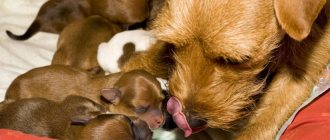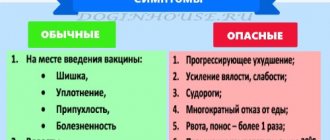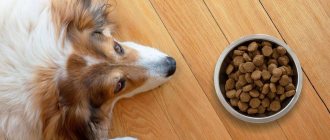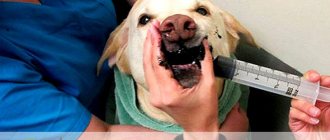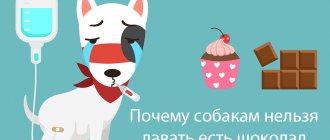When a puppy appears in our house at first, we carefully monitor its behavior. We begin to care for him as if we were our own child.
And every owner will be seriously concerned if, after feeding, the baby vomits undigested food . And if this phenomenon turns into a regular process, our excitement knows no bounds.
Let's take a closer look at the reasons for vomiting undigested food, and whether you should worry.
Vomiting up undigested food
On average, the time from food intake to entering the intestines in puppies is from 3 to 5 hours. This figure depends on the type of food.
- Dry food takes longer to digest; on average, the journey to the intestines takes five hours.
- For natural food it’s faster – about three hours.
The final digestion of food takes:
- With natural feeding, six hours.
- When feeding dry food, final digestion takes an average of eight hours.
Reference! You need to understand the difference between vomiting and regurgitation.
- Vomiting is accompanied by strong salivation and has many different causes. When vomiting, the animal most often changes in behavior, and anxiety is noticeable. During this process, the whole body is involved, the puppy may back away and hunch over.
- Regurgitation does not cause much discomfort for the dog. Most often in puppies this is due to overeating.
Possible complications
Regurgitation in itself does not pose a risk to your pet's health. But in case of frequent and profuse vomiting, the body loses water and does not receive nutrients from food. Therefore, the main consequences for the dog can be anemia and dehydration. If there are foreign bodies in the digestive tract, bleeding may occur.
Other specific complications may develop as a result of chronic problems with internal organs.
Why do you feel sick?
When a baby vomits undigested food, this does not always signal that the puppy has health problems.
A little one may simply be in a hurry while eating . This may be caused by the presence of another animal nearby - the puppy is afraid that his food will be taken away. It is also possible that the pet has become very hungry since the last feeding and wants to quench its appetite as much as possible.
In such a situation, feed the puppy separately from other animals and do not skip feeding times.
If the puppy vomited not immediately after eating, but during a trip in transport, then he simply got seasick . Before a trip, it is better not to feed dogs prone to motion sickness; this will help make the trip more enjoyable for you and your pet.
Possible vomiting after a walk. This means that the puppy ate grass outside . As you know, animals cleanse their stomachs in this way. If this is the case, then in addition to undigested food, white or yellowish foam will be present in the vomit.
Many owners overfeed their pets. This can cause vomiting of undigested food. In simple words, the food does not fit in the stomach and comes out back. In such a situation, reduce the portion. In addition to vomiting, overeating can cause stomach distension and obesity.
Dogs are also overly active at an early age. If you notice that after eating the puppy begins to run and jump , do not be surprised if vomiting occurs. To somehow avoid your baby's active play after eating, hold him in your arms; if he is already large enough, sit next to him and stroke him. The owner's attention will distract the puppy.
Your pet may choke on food, water or air. If this is the case, then vomiting will occur immediately after the puppy chokes.
In hot weather, a dog may experience heatstroke , a symptom of which may be vomiting, and babies are more susceptible to this. To avoid this, do not take your puppy outside unless absolutely necessary in hot weather.
Now you know in which cases you shouldn’t worry, you just need to follow the recommendations and everything will be fine. Well, what if the puppy is vomiting like a fountain?
Causes of yellow vomiting
Poisoning
A dog can be poisoned by something picked up on the street, chemicals, or various medications. In addition, dogs have a special interest in spoiled foods. A pet can find them on the street, in the trash, sometimes food can lie in a bowl for a long time and spoil. Dry food can become a victim of fungi and bacteria.
Symptoms depend on what the dog was poisoned with, the most common: vomiting and diarrhea, lethargy, shortness of breath, trembling, loss of coordination.
In the first 40 minutes from the moment of eating, you can drink enterosorbents. If there is a veterinary clinic nearby, then in the first hour after eating, the veterinarian may induce vomiting in the pet. If you know what exactly the dog was poisoned with, tell your doctor about it; perhaps there is a specific antidote. In addition, symptomatic therapy is used: antiemetics, painkillers, anticonvulsants, etc., as well as drip infusions to remove toxins from the blood.
Gastrointestinal obstruction
Dogs often vomit yellow foam due to intussusception, gastric volvulus, and swallowing stones, toys, rags, and other objects.
Intussusception is a condition in which the intestines curl in on themselves. This happens more often in young animals because their intestinal wall is still thin.
Gastric volvulus is a dangerous condition; large dogs are prone to it when they overeat.
If there is an obstruction, the dog vomits food, water, bile, and yellow foam. All this is accompanied by drooling, acute pain, and sometimes bloating. The pet may try to eat and drink, but everything he swallows will be vomited after some time.
Treatment is almost always surgical; in rare cases, it is possible to remove the foreign object using laxatives and enemas.
Infections
Bacteria and viruses can also cause vomiting. Diarrhea, loss of appetite, lethargy, and high body temperature also occur. Treatment depends on the specific disease. Antibiotics, antiemetics, drip infusions, diet, etc. are used.
Infestations
This is a group of diseases caused by parasites entering the body. When infested, the dog periodically vomits bile; diarrhea, mucus, blood and helminths may also appear in the feces. Animals lose weight despite normal appetite. In case of acute damage, there may be refusal to eat, lethargy, pain, and bloating. For treatment, drugs are used to destroy parasites in combination with symptomatic therapy.
Diet violation
When eating too fatty foods, smoked foods, excess spices, or when regularly feeding them from the table, vomiting occurs quite often in dogs.
Diarrhea also occurs, and if untreated, the dog vomits bile even without food; there may be refusal to eat, lethargy, and abdominal pain.
If vomiting occurs once, then symptomatic therapy (antiemetics, antispasmodics, diet correction) is sufficient. But if the diet is violated regularly, this leads to serious consequences. The groups of drugs will depend on what kind of disease caused the dog's diet.
Non-infectious diseases of the stomach and intestines
Inflammation of the stomach and small intestine can occur due to stress, genetics, autoimmune processes, and intolerance to certain foods.
The disease can be complicated by the occurrence of ulcers and erosions on the mucous membranes. In addition to vomiting, pain, diarrhea, and refusal to eat often occur.
For treatment, antiemetics, antacids (drugs that reduce stomach acidity), a low-fat diet, and antibiotics are used. Autoimmune processes require the use of immunosuppressive therapy.
Liver and gallbladder diseases
Hepatitis, cholangitis, cholecystitis and other diseases of the hepatobiliary system are also manifested by vomiting.
As a rule, with these diseases, the dog vomits a yellow liquid with foam in the morning. The color of the stool also changes, it becomes lighter or completely white. There may be diarrhea, mucus in the stool, loss of appetite and pain in the right hypochondrium. In severe cases, the mucous membranes and skin take on an icteric (icteric) tint.
Treatment includes diet, hepatoprotectors, antispasmodics, antiemetics, and antibiotics.
Tumors
Sometimes tumors affect the gastrointestinal tract or neighboring tissues. In addition to vomiting, weight loss occurs with preserved appetite, diarrhea, perversion of appetite (licking walls, eating inedible objects). Treatment is almost always surgical. Radiation or chemotherapy may also be required.
Pancreatic diseases
Inflammation of the pancreas (pancreatitis) or its necrosis (death) is accompanied by periodic vomiting, acute abdominal pain, loss of appetite, and possible diarrhea. A common symptom is a strange dog posture, which is called the “praying dog pose.” In the early stages, antiemetics, diet, painkillers, and drip infusions are used to help the pet. Necrosis may require surgery.
Endocrine pathologies
Vomiting can be a secondary symptom of hyperadrenocorticism (adrenal gland disease) and diabetes. In addition to vomiting, thirst and appetite increase, the pet’s activity level changes, the skin becomes thinner, and skin damage does not heal for a long time. Treatment includes symptomatic and hormonal (replacement) therapy.
Hurry up, choose a box and find out what gift awaits you
Discount on pet insurance
Promo code copied to clipboard
Kidney diseases
Kidney damage (nephritis, renal failure) is accompanied by general intoxication (azotemia) and often leads to uremic gastritis.
The first symptoms of kidney damage are lethargy, changes in thirst, increased volume of urine, decreased appetite, and weight loss. During treatment, it is important to adjust the level of electrolytes and the pet’s drinking regimen (diet, drips). Drugs that relieve symptoms affecting renal blood flow and blood pressure, as well as a diet low in phosphorus, are used.
Heatstroke
Dogs have always had problems with heat transfer. Unlike humans, they do not sweat. Their fur protects them from the sun and heat; thermoregulation occurs through breathing. At high temperatures this may not be enough, which can lead to heat stroke. In addition to vomiting, diarrhea, unsteadiness of gait or even fainting, rapid breathing, and redness of the mucous membranes often occur. Treatment consists of cooling the pet to its normal temperature and replenishing fluid deficiency.
Motion sickness in transport
Pets can also get motion sickness in transport. Prepare for the trip in advance: do not feed your pet 4 hours before travel, make stops every 1-2 hours. What to do if your dog vomits bile on the road? It is enough to give her a break, and before the trip you should use anti-motion sickness medications.
Taking certain medications
You should not use anti-inflammatory drugs (steroidal and non-steroidal) without a doctor’s prescription; drugs from the human pharmacy, such as paracetamol, diclofenac, ibuprofen, ketorol and others, are especially dangerous. In addition to vomiting, they can cause diarrhea, blood in vomit and stool, lethargy, and severe abdominal pain. Sometimes bleeding develops, which will be complicated by signs of blood loss and shock.
Treatment is symptomatic, gastroprotectors, enveloping agents, antiemetics, droppers, and a special diet are prescribed. Acute blood loss may require a transfusion.
Vomiting fountain
Reference! This phenomenon is caused by vomiting with the release of food and water with particular force. This is where the name comes from; vomit can be spewed over a distance of several steps.
Puppies between 6 and 16 weeks are more likely to suffer from this problem. Vomiting occurs due to the inability to remove food and water from the stomach into the intestines. With this type of vomiting, it is recommended to monitor whether the baby is losing weight. This type of vomiting may be a signal that surgery is needed.
Causes of regurgitation
Regurgitation often occurs due to:
- Haste. If there are several pets at home, the dog may eat his portion too quickly to avoid sharing with others. Because of this, the stomach fills too quickly and food comes in large pieces. This is what causes regurgitation.
- Gluttony. If the dog does not know how to control his food needs, he may eat more than his stomach can accommodate.
- Games Most often, this is a problem with puppies, who immediately after eating begin to run actively, and their fragile stomach cannot hold food.
- Puppies. A mother may regurgitate food to feed her offspring, who no longer drink milk and cannot eat solid food.
- External factors. Irregular regurgitation can occur due to heat, changes in diet, and emotional stress.
Also, your pet may periodically regurgitate grass. The dog plucks it specifically to cleanse its digestive tract.
Age characteristics
Puppies are more susceptible to vomiting undigested food. This is due, as already listed above, to high mobility, improper eating habits, and worms, which cause more obvious symptoms in children than in adult dogs.
Also, at an early age, a dog may swallow a foreign object, such as a piece of a toy, which can lead to vomiting.
What to do at home
If you frequently regurgitate food, the first thing to do is call a doctor or go to a veterinary clinic. Then you need to make sure that the dog does not eat anything before visiting the doctor. You can only drink, especially with frequent vomiting or diarrhea.
Until the diagnostic results are obtained, it is better not to take steps to combat vomiting. It is recommended to simply calm the pet. At this time you need to pay attention to:
- amount of vomit;
- color and consistency;
- frequency of regurgitation;
- presence of other symptoms.
This will speed up the correct diagnosis.
Feed selection
Inexperienced dog breeders need to know that the dog should absolutely not be fed from the table . If the animal does not eat sausage, fried or smoked, this will help prevent vomiting.
Also, many owners often give their pets bones. This also cannot be done. Chicken ones are especially dangerous - they are hollow inside and, when chewed, break into sharp fragments. This can severely damage the stomach wall.
Proper feeding from one month of age
With dry food everything is simple, you select it according to age and breed.
Important! If you adopted a puppy a little older than a month, the food should be soaked at first.
If you feed your pet natural food, then you need to remember a few rules:
- The diet should include grains and make up 25 percent of the daily value.
- Vitamins, also 25 percent. You can use fish oil, bone meal, nutritional yeast, ascorbic acid, some vegetables and fruits.
- Meat - chicken, turkey, beef and lean pork. It is better to give it boiled or chop it finely and pour boiling water over it.
- Meat soup products.
- Fish, preferably oceanic.
- Dairy products. Not recommended in combination with meat products.
If a prompt visit to the veterinarian is not possible
To provide first aid to a pet, you first need to ensure that the dog is calm. Remove the bowl of food for 1-2 hours. If you vomit repeatedly, do not delay visiting your doctor.
Under no circumstances should you give medications orally if you are vomiting repeatedly; the medications will not just come back out, but can also worsen the condition.
If vomiting is associated with heat stroke, you should place your pet in a cool place, wipe it with a damp cloth, and give free access to fresh water.
In cases with single vomiting, you need to change the frequency of feeding, that is, feed more often, but in smaller portions. In such situations, enveloping drugs can be used. However, the doses of the medicine must be calculated by a veterinarian, and many of them have contraindications.
In order to understand whether it is possible to give this or that medicine to your pet, you can contact Petstory therapists for an online consultation in the mobile application. You can install the application using the link.
Diseases
Vomiting in a puppy can be caused by congenital abnormalities. There are also diseases that are accompanied by symptoms such as :
- loss of appetite;
- apathy;
- increased body temperature;
- diarrhea.
The most common diseases associated with gastrointestinal disorders :
- Ulcer. There is a decrease in appetite, severe thirst, pain in the abdomen when palpated, vomiting and diarrhea. The dog also takes an unnatural position, which makes it easier for him.
- Gastritis. This disease is characterized by vomiting immediately after eating undigested food or on an empty stomach. Decreased appetite; vomit may contain blood or bile.
- Enteritis. Accompanied by complete refusal of food and water, severe fever, vomiting, diarrhea, weakness and trembling in the limbs.
The dog vomited after eating: the differences between vomiting and regurgitation
The dog vomited after eating: what is the difference between vomiting and regurgitation? During vomiting, stomach spasms occur. Food mixed with acidic liquid from the stomach foams slightly when exposed to air.
Regurgitation is the expulsion of small amounts of food along with air that was swallowed while eating. Some dog breeds are prone to regurgitation, especially those with depressed or upturned noses.
When burping, the dog does not lower its head; on the contrary, it raises it, stretching its neck. Immediately after regurgitation, the dog breathes normally, and after vomiting there is a deep, sharp breath.
Impurities in vomit
Vomit should be examined for the presence of mucus, foam, bile or blood.
Blood
If blood clots are detected, you should immediately contact a veterinarian . Its presence in vomit indicates serious illness and internal hemorrhage.
Yellow liquid
This is the secretion of bile. The cause may be poor nutrition or overeating. But this phenomenon can also indicate serious diseases . You shouldn’t put off going to a specialist either.
Green
Vomiting undigested food in which you notice green liquid most likely indicates a serious illness . This may be duodenal obstruction, infection, or the presence of worms.
Diagnostics in a veterinary clinic
Initially, a veterinarian can determine the degree of danger of regurgitation for a pet by the state of the vomit:
- Half-digested food is not a cause for concern.
- The presence of blood can be a symptom of various diseases, such as cancer.
- An admixture of bile and feces is the first sign of intestinal obstruction.
- A strong odor of ammonia appears when kidney function is impaired, uremia.
For a more accurate diagnosis, the veterinary clinic will take a blood test, perform an ultrasound and x-ray of the abdominal organs.
What to do if nausea does not stop for a long time?
If the food has already come out, but the vomiting still does not stop and there is still diarrhea, go to a specialist as soon as possible. The combination of these factors leads to dehydration. This is especially dangerous for puppies from one month of age.
Attention! Dehydration in puppies can be fatal in just 24 hours.
To somehow alleviate the baby’s condition before visiting the veterinarian, do not feed him in the first place. If the puppy also vomits after drinking, eliminate the water; instead, you can give an ice cube or chamomile tea. The pet should be given activated charcoal.
Signs of vomiting caused by illness
The main sign indicating a pathological origin of vomiting is the animal’s well-being. If the puppy is lethargic and apathetic, he should be seen by a veterinarian immediately . However, the timing of vomiting is no less important.
Vomiting immediately after feeding: what does this phenomenon indicate?
As a rule, if a puppy “throws up” immediately after feeding, this may indicate the following origin of vomiting:
- Or it is very bad food, which the animal’s body does not perceive at all.
- Or maybe the puppy has something very wrong with his stomach. In particular, vomiting a few minutes after eating food is a characteristic sign of acute gastritis (or chronic, but in a state of exacerbation).

